Understanding Qualcomm's Snapdragon 810: Performance Preview
by Joshua Ho & Andrei Frumusanu on February 12, 2015 9:00 AM EST- Posted in
- SoCs
- Qualcomm
- Mobile
- Gobi
- Snapdragon 810
CPU/System Performance
While talking about the energy aware scheduler and various other aspects of the Snapdragon 810 is helpful to understand how the SoC works, ultimately we must look at performance to determine whether Qualcomm's work to differentiate their SoC was worthwhile or not. To do this, we ran Qualcomm's tablet Mobile Development Platform (MDP) through our standard suite of benchmarks, although I was unable to run benchmarks such as BaseMark X and PCMark due to odd issues with the tablet.
Starting off, we have a complete breakdown of GeekBench 3 scores. The scores are closer to theoretical performance than real-world performance, but it's very useful for highlighting architectural changes. For our look at GeekBench we are comparing the 810 reference platform to our results from our recent Galaxy Note 4 Exynos review, along with results for the Snapdragon 805-based Galaxy Note 4 taken from the GeekBench database.
| GeekBench 3 - Integer Performance | |||||||
| Snapdragon 805 (ARMv7) | Exynos 5433 (AArch32) | Snapdragon 810 (AArch64) | S810 > S805 % Advantage | ||||
| AES ST | 85.4 MB/s | 1330 MB/s | 604.9 MB/s | 608% | |||
| AES MT | 350.4 MB/s | 4260 MB/s | 3050MB/s | 770% | |||
| Twofish ST | 94.0 MB/s | 81.9 MB/s | 85.7 MB/s | -8.8% | |||
| Twofish MT | 329.8 MB/s | 440.5 MB/s | 448.5 MB/s | 36% | |||
| SHA1 ST | 202.1 MB/s | 464.2 MB/s | 428.1 MB/s | 112% | |||
| SHA1 MT | 806.1 MB/s | 2020 MB/s | 3019 MB/s | 275% | |||
| SHA2 ST | 95.1 MB/s | 121.9 MB/s | 81 MB/s | -15% | |||
| SHA2 MT | 367.3 MB/s | 528.3 MB/s | 393.4 MB/s | 7.1% | |||
| BZip2Comp ST | 4.46 MB/s | 4.88 MB/s | 4.99 MB/s | 12% | |||
| BZip2Comp MT | 15.5 MB/s | 19.3 MB/s | 20.5 MB/s | 32% | |||
| Bzip2Decomp ST | 6.43 MB/s | 7.41 MB/s | 7.99 MB/s | 24% | |||
| Bzip2Decomp MT | 21.7 MB/s | 29.7 MB/s | 30.8 MB/s | 42% | |||
| JPG Comp ST | 20.4 MPs | 19.3 MPs | 18.9 MP/s | -7.4% | |||
| JPG Comp MT | 79.9 MP/s | 88.8 MP/s | 88.9 MP/s | 11% | |||
| JPG Decomp ST | 30.6 MP/s | 43.5 MP/s | 36.3 MP/s | 19% | |||
| JPG Decomp MT | 115.7 MP/s | 149.6 MP/s | 182.7 MP/s | 58% | |||
| PNG Comp ST | 0.82 MP/s | 1.11 MP/s | 1.11 MP/s | 35% | |||
| PNG Comp MT | 3.01 MP/s | 4.57 MP/s | 4.78 MP/s | 59% | |||
| PNG Decomp ST | 18.7 MP/s | 19.1 MP/s | 15.6 MP/s | -17% | |||
| PNG Decomp MT | 63.7 MP/s | 78.8 MP/s | 94.1 MP/s | 48% | |||
| Sobel ST | 39.2 MP/s | 58.6 MP/s | 53.3 MP/s | 36% | |||
| Sobel MT | 128 MP/s | 221.3 MP/s | 248.4 MP/s | 94% | |||
| Lua ST | 0.92 MB/s | 1.24 MB/s | 1.30 MB/s | 41% | |||
| Lua MT | 1.36 MB/s | 2.48 MB/s | 5.93 MB/s | 336% | |||
| Dijkstra ST | 4.46 Mpairs/s | 5.23 Mpairs/s | 3.38 Mpairs/s | -24% | |||
| Dijkstra MT | 13.2 Mpairs/s | 17.1 Mpairs/s | 13.7 Mpairs/s | 3.8% | |||
Thanks in large part to the new cryptographical capabilities of the ARMv8 cores, Snapdragon 810 gets off to a very good start in GeekBench 3's integer benchmarks. Once we move on to the rest of our benchmarks, we find that 810 continues to hold a considerable advantage through most of these benchmarks; BZip2 decompression, Lua script performance, and JPEG decompression all show considerable performance gains over the Snapdragon 805 based Galaxy Note 4. Snapdragon 810's overall performance improvement here is a rather large 45%, though if we throw out the especially large gains that come from Lua MT, the overall performance advantage is closer to 30%.
There are a few cases where performance regresses however, including in PNG decompression and Dijkstra's algorithm. This could be a result of memory performance (more on that later) or architectural differences. It's worth pointing out that these cases are also among the only cases where Snapdragon 810 notably trails the Exynos 5433.
| GeekBench 3 - Floating Point Performance | |||||||
| Snapdragon 805 (ARMv7) | Exynos 5433 (AArch32) | Snapdragon 810 (AArch64) | S810 > S805 % Advantage |
||||
| BlackScholes ST | 4.33 Mnodes/s | 4.37 Mnodes/s | 5.01 Mnodes/s | 16% | |||
| BlackScholes MT | 17.0 Mnodes/s | 20.4 Mnodes/s | 25.5 Mnodes/s | 50% | |||
| Mandelbrot ST | 0.87 GFLOPS | 1.14 GFLOPS | 1.20 GFLOPS | 38% | |||
| Mandelbrot MT | 3.45 GFLOPS | 5.09 GFLOPS | 6.41 GFLOPS | 86% | |||
| Sharpen Filter ST | 886 MFLOPS | 1030 MFLOPS | 1007 MFLOPS | 14% | |||
| Sharpen Filter MT | 3.54 GFLOPS | 4.31 GFLOPS | 5.02 GFLOPS | 42% | |||
| Blur ST | 1.18 GFLOPS | 1.27 GFLOPS | 1.26 GFLOPS | 6.8% | |||
| Blur MT | 4.67 GFLOPS | 5.03 GFLOPS | 6.14 GFLOPS | 31% | |||
| SGEMM ST | 2.82 GFLOPS | 1.81 GFLOPS | 2.29 GFLOPS | -19% | |||
| SGEMM MT | 8.05 GFLOPS | 6.1 GFLOPS | 6.12 GFLOPS | -24% | |||
| DGEMM ST | 0.81 GFLOPS | 0.57 GFLOPS | 1.03 GFLOPS | 27% | |||
| DGEMM MT | 2.69 GFLOPS | 2.29 GFLOPS | 2.81 GFLOPS | 4.5% | |||
| SFFT ST | 1.16 GFLOPS | 1.1 GFLOPS | 1.25 GFLOPS | 7.8% | |||
| SFFT MT | 4.55 GFLOPS | 4.56 GFLOPS | 4.11 GFLOPS | -9.7% | |||
| DFFT ST | 0.47 GFLOPS | 1.02 GFLOPS | 1.03 GFLOPS | 119% | |||
| DFFT MT | 1.89 GFLOPS | 3.46 GFLOPS | 2.97 GFLOPS | 57% | |||
| N-Bod ST | 331.5 Kpairs/s | 370.4 Kpairs/s | 486.6 Kpairs/s | 47% | |||
| N-Bod MT | 1.12 Mpairs/s | 1.44 Mpairs/s | 1.72 Mpairs/s | 54% | |||
| Ray Trace ST | 1.48 MP/s | 1.7 MP/s | 1.73 MP/s | 17% | |||
| Ray Trace MT | 5.77 MP/s | 6.65 MP/s | 8.16 MP/s | 41% | |||
GeekBench's floating point performance shows a similar range of performance increases. More often than not multi-threaded performance gains exceed single-threaded performance gains, which is a hopeful sign for how well the Snapdragon 810 reference platform can hold up when all four big cores are being hammered. Otherwise the 810 shows considerable performance gains on almost every benchmark here, the sole exception being SGEMM performance.
In this case Snapdragon 810 performance is relatively close to Exynos 5433 performance even though it has the advantage of running in AArch64 mode, which should give the FP numbers a boost over the Exynos. The SGEMM test is likely an isolated case where the Krait architecture and Snapdragon 805's high clock speed play to its favor. The overall Snapdragon 810 performance improvement is 30%, almost exactly what we saw with GeekBench integer performance as well (after throwing out Lua MT).
| GeekBench 3 - Memory Performance | ||||||
| Snapdragon 805 (ARMv7) | Exynos 5433 (AArch32) | Snapdragon 810 (AArch64) | S810 > S805 % Advantage |
|||
| Stream Copy ST | 8.37 GB/s | 5.56 GB/s | 6.02 GB/s | -28% | ||
| Stream Copy MT | 10.2 GB/s | 5.80 GB/s | 7.57 GB/s | -26% | ||
| Stream Scale ST | 5.17 GB/s | 4.98 GB/s | 6.61 GB/s | 28% | ||
| Stream Scale MT | 8.05 GB/s | 5.77 GB/s | 7.37 GB/s | -8.4% | ||
| Stream Add ST | 5.06 GB/s | 4.85 GB/s | 5.64 GB/s | 11% | ||
| Stream Add MT | 7.46 GB/s | 5.72 GB/s | 6.62 GB/s | -11% | ||
| Stream Triad ST | 5.37 GB/s | 4.82 GB/s | 5.6 GB/s | 4.3% | ||
| Stream Triad MT | 8.20 GB/s | 5.73 GB/s | 6.63 GB/s | -19% | ||
Usually we don't like to post the GeekBench memory scores, but in this case there is an interesting phenomenon going on with the Snapdragon 810. Although the LPDDR4 memory running at 1555MHz gives the SoC a large advantage in memory bandwidth over the Exynos 5433 and runs its CCI at 787 MHz, giving the CPU port a theoretical 12.6 GB/s that's much more than the 6.6GB/s of the 5433, the actual measured bandwidth difference is much less and is nowhere near that figure in any of the sub-tests.
To look at this in more detail, we use AndEBench's memory benchmarks, and indeed we see a similar result.
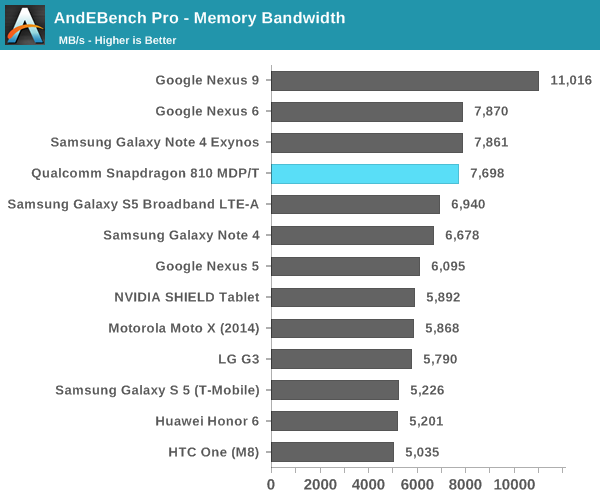
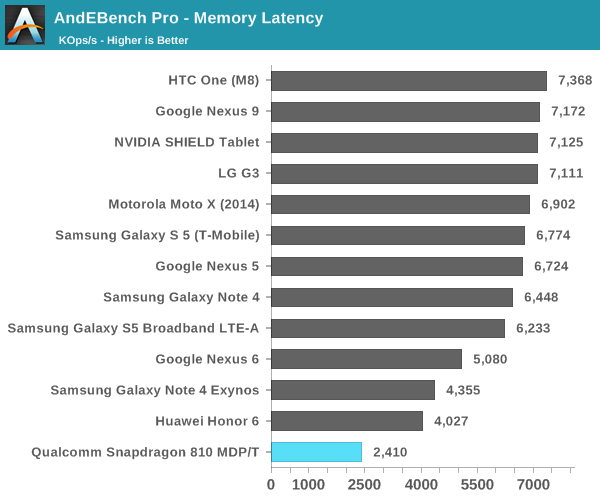
It's the memory latency test in particular that's very worrisome, as the MDP tablet achieves a very bad throughput score. We're not sure why this happens, but we hope to investigate this further in the future when we get the chance to review a shipping Snapdragon 810 device.
Continuing on, let's look at our browser bench suite.
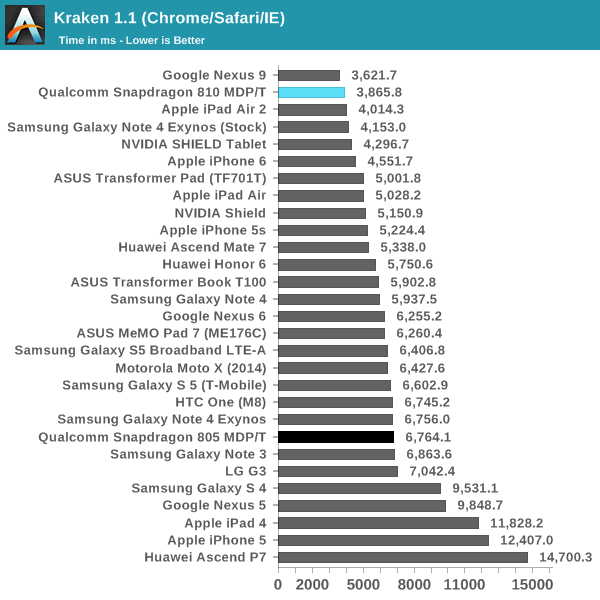
Here, the Snapdragon 810 is off to quite a start. While not a direct correlation, performance in these benchmarks can generally be correlated with CPU performance. The Snapdragon 810 shines here and approaches the Nexus 9, which has a strong showing due to the underlying Denver CPU's code optimizer unrolling loops in the benchmark.
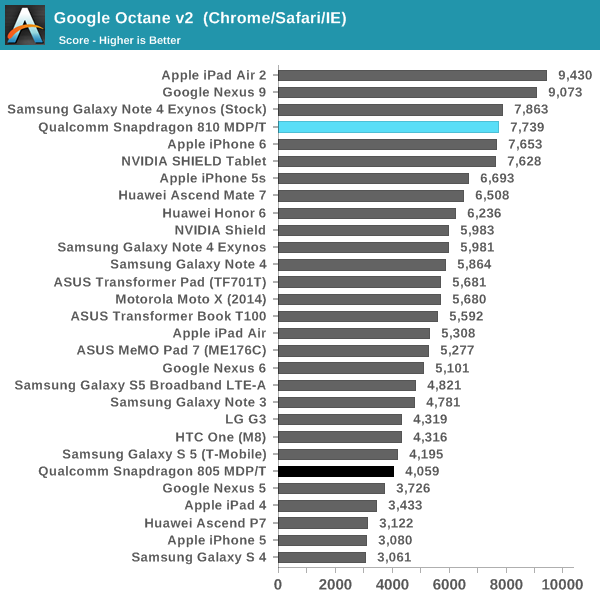
In Octane, we see that the Snapdragon 810 continues to be competitive with some of the fastest SoCs available today.
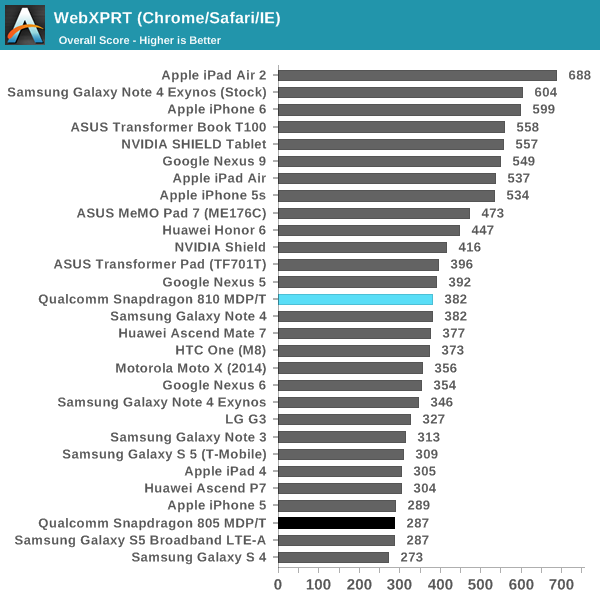
On the other hand, in WebXPRT we see that performance ends up somewhere around the level of the Snapdragon 801. It's possible that we're looking at thermal throttling or some other issue here as I was unable to run multiple trials of this test. Our browser based tests are otherwise generally consistent with what we found earlier this week on the A57-based Exynos 5433, so it's unlikely we're looking at an unoptimized Chrome build.
Continuing with the benchmarks we were able to perform at the performance preview, BaseMark OS II is next.
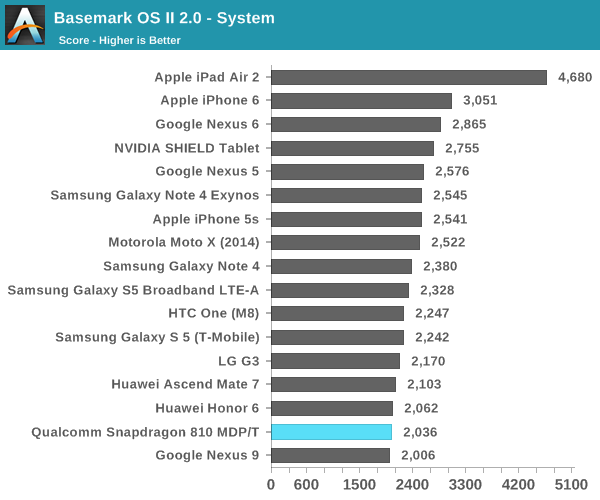
The System numbers of the Snapdragon 810 MDP/T seem disappointing, as it falls at the lower end of our current flagship device lineup. It seems the reference platform isn't as well optimized as it should be.
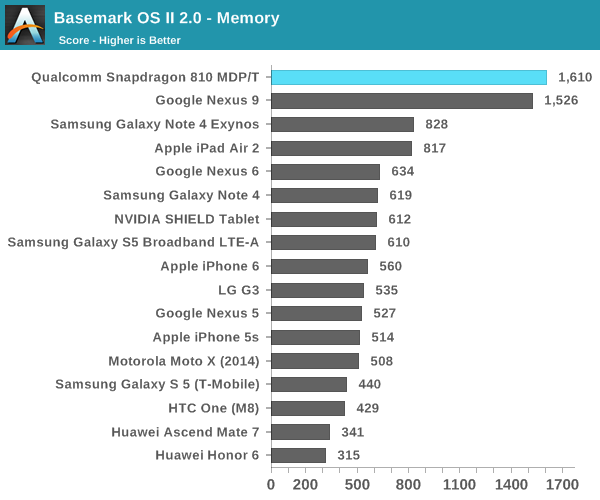
Similar to the Nexus 9, we see some odd trends in the memory tests. It isn't quite clear what's causing this, but a performant eMMC is certainly a possibility. Due to this test being very device specific, we can't really judge the Snapdragon 810's performance here.
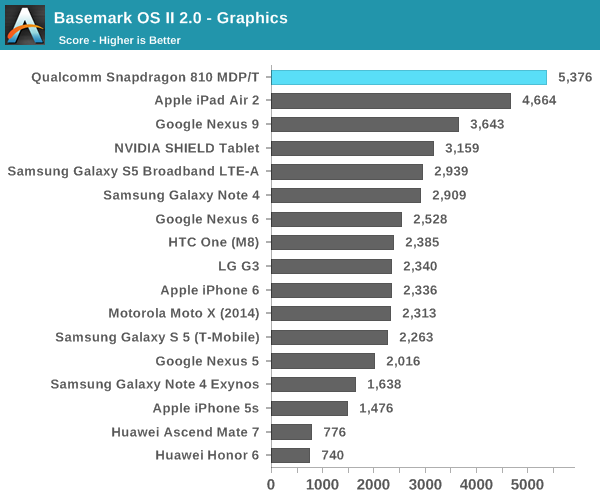
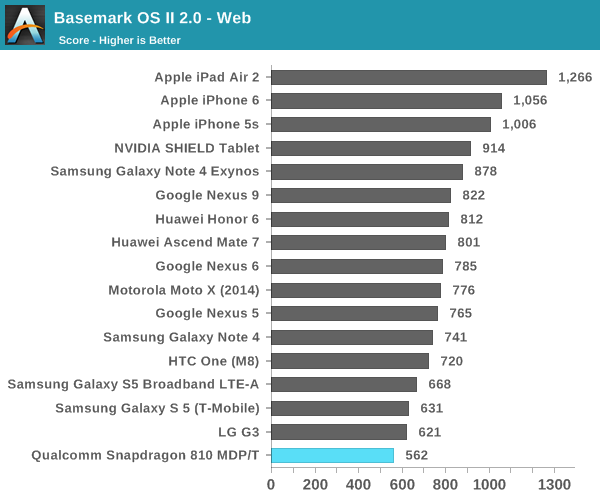
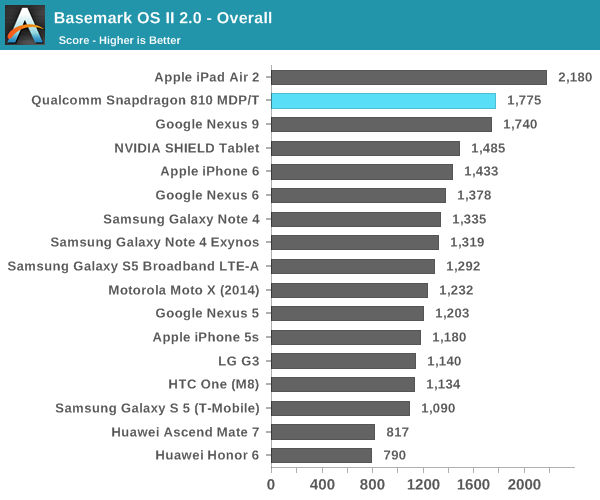
As for BaseMark, what we get are very binary results with the 810 either coming in near the top or bottom. The overall score still looks quite good as a result, boosted by things such as chart-topping graphics performance. On the other hand the web and system scores are struggling, coming in 20% or more behind the Note 4 and it's A57 based Exynos 5433. Since this is an early device this may be a case of early teething issues with performance, possibly with optimizations or the OS, but at this point in time it's difficult to confirm anything.
Meanwhile looking at how Qualcomm's reference platform compares to the Snapdragon 805-based Nexus 6, we find some significant performance gains at times. Though Krait has held up admirably against its A15 based competition, A57 finally provides a solid jump in performance over what even the fastest Krait can offer.










119 Comments
View All Comments
TerdFerguson - Thursday, February 12, 2015 - link
I'm inclined to agree with you, especially after seeing the dual-channel 32-bit bus being described as having a total of 64 bits. Wow, that's as bad as marketing for 1990s consoles.extide - Thursday, February 12, 2015 - link
How is that bad marketing? A dual channel 32-bit bus IS effectively 64-bits wide ...dawheat - Thursday, February 12, 2015 - link
The reference platform has a 6.2” display - making it quite the gigantic phone. I'm guessing it avoids thermal issues which may impact other, more normal size phones.Andrei Frumusanu - Thursday, February 12, 2015 - link
The preview tests were actually done on the MDP tablet, not the MDP phone.dawheat - Thursday, February 12, 2015 - link
Ouch - then this is really best-case performance of the S810 as I'd imagine the tablet MDP has way higher thermal headroom than the phones it's being compared to.lopri - Thursday, February 12, 2015 - link
I am usually very harsh on reviewers, but I do not think your argument holds up. Exynos 5433 is a vanity product. While technically interesting, it is used for one product (afaik) and even that product is not widely available. I would definitely prefer to learn the improvement of the S810 over S800/S805, being Qualcomm's generational product.And it is not like the review tried to hide the Exynos 5433 or anything. The numbers are right there for you to see. Furthermore, AT covered the Exynos 5433 very extensively only a few days ago.
Likewise, throttling or power is meaningless at this stage without knowing what the shipping product is going to be like. And I expect to see those information in due time. Unless you can point to false benchmark data, I do not see the merit in picking on every single aspect of an SOC that was not covered (yet).
Not everyone wants to read corporate conspiracy theories on a tech article, either. I, for one, do not like to read unverified rumors in a technical article.
Only thing that I agree with you about is the missing clock frequency information on the charts. But again, the focus is rightfully on S805 v. S810. I will give the authors a benefit of doubt.
Only thing that I do not like about the article is its timing. I mean, I haven't even finished the Exynos 5433 article yet and there are already 2 laptop articles and now an introduction to the S810.. It's too much information for me to digest. Obviously this is a subject point, and I do not expect everyone to agree with me.
warreo - Thursday, February 12, 2015 - link
Exynos 5433 is indeed a vanity product, nobody is arguing otherwise. You are missing the point that I made earlier. Exynos 5433 is the immediate predecessor to the 7420. Hence, comparing the S810 to the 5433 is a good starting point for how the S810 will compare to the 7420, and it would be one completely based on real, hard data, not just speculation. Are you honestly saying that you would not be interested in a better preview of how the S810 vs. Exynos 7420 will shake out?lopri - Thursday, February 12, 2015 - link
I mean, if AT really wanted to boost S810's image the authors could have omitted the number from 5433 in Geekbench sub-score comparison. The rest of the charts also look free of manipulation, so I do not see how you get the impression.As you can see from this very comment section, not everyone is impressed by the S810. Apparently the authors did not do a good enough job - you know, the job you are insinuating here.
warreo - Thursday, February 12, 2015 - link
True enough, but the fact that AT provides the 5433 data makes it more mystifying why they almost completely gloss over it in the text (not to mention not provide the % differences in the tables). Josh and Andrei have already stated they intentionally kept the focus on S805 vs. S810, but my point is this would be a much stronger article if there was more depth given to the Exynos 5433 comparison. Clearly, I'm not the only one who thinks so.Tchamber - Friday, February 13, 2015 - link
@warreoGet over yourself. So far the 5433 has made it into one product. We all know that it's a good performer, but the Snapdragon line makes it into many more devices...always has. What your asking would be like me writing to Car and Driver and saying "hey, you are guys are doing your comparisons wrong. I want you test your Corvettes, Camarros, and GT500s against a Lamborghini Aventador." Well, they have all the test results from the Lamobo...but that's just not what the others were made to compete with, so it would be meaningless to run them against each other at the road course. Do your own math if you don't like not seeing a percent sign with easy to digest material. All the time you've been talking down to AT you could have posted your own conclusions and helped out all those people who agree with you.